 Leading Blog | Posts by Month |
 Leading Blog | Posts by Month |
03.31.21

LeadershipNow 140: March 2021 Compilation
See more on
Posted by Michael McKinney at 08:41 AM
03.25.21

Leading Thoughts for March 25, 2021
IDEAS shared have the power to expand perspectives, change thinking, and move lives. Here are two ideas for the curious mind to engage with: Fred Kofman on what it means to be a transcendent leader: “Transcendent leaders work to align the individual purposes of those under them into a larger collective purpose that makes each individual larger as well. They understand that if you want to make accountability and cooperation occur at the same time, you need to inspire people and create a culture of commitment and connection to a larger purpose. When this happens, people look beyond their silos and their small decision-making issues. They align their best efforts with the organization’s in natural ways that other systems can’t lead them to do. It is the difference between rowing and sailing. A boat moved by mere muscle is no match for one moved by wind. A boat propelled by the wind flows in harmony with the natural forces. An organization that moves forward by formal authority is like a rowboat. One moved by transcendent purpose is like a sailboat with the wind behind it, filling its sails.” Source: The Meaning Revolution: The Power of Transcendent Leadership Scientist and mathematician Richard Hamming on the purpose of education: “Teachers should prepare the student for the student’s future, not for the teacher’s past.” Source: The Art of Doing Science and Engineering: Learning to Learn Look for these ideas every Thursday on the Leading Blog. Find more ideas on the LeadingThoughts index.
Posted by Michael McKinney at 08:30 AM
03.22.21

Everyday People, Extraordinary Leadership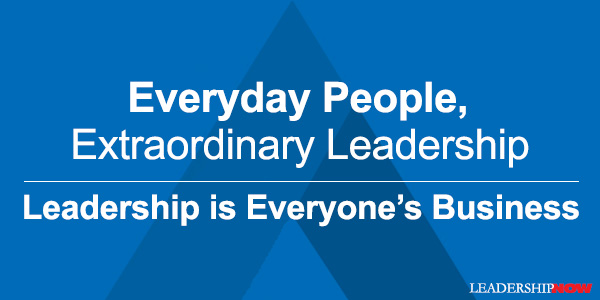
LEADERSHIP is a mindset—a way of approaching life. It is about how you behave and what you do. It can be taught and then tested and refined in practice. We all have a responsibility to lead in the context we are in. James Kouzes and Barry Posner emphasize this point in Everyday People, Extraordinary Leadership. The book is about what “individuals do to effect change and improvement.” Most leaders do not have titles. And this book is written for them – those people who can and should lead “without the benefit of hierarchical position and rank.” To help you develop confidence and grow as a leader, the authors present an operating system of leadership practices based on their time-tested Five Practices of Exemplary Leadership. Together they define what leaders do. Leadership is fundamentally about your relationships, your credibility, and what you do. Leadership has everything to do about how you behave. The authors share the personal stories of ordinary people who stepped up and behaved as informal leaders. When you read these stories of people from all walks of life who lead at their personal best, they demonstrated a common set of behaviors and actions that the authors have grouped together in the Five Practices: Model the Way
Modeling the Way begins with knowing and being able to articulate your values. But good leadership goes beyond that. “Successfully leading others requires an understanding and affirmation of shared values—the principles that can galvanize and strengthen collective commitment.” Inspire a Shared Vision
To follow your vision, people must see how they can make it their own. You must understand the hopes and aspirations of those you are involved with. You must breathe life into visions, not only by your own enthusiasm and expressiveness but by listening to and communicating the hopes and dreams of others so that they clearly understand how their values and interests will be served. Challenge the Process
Be willing to experiment and learn from your mistakes and setbacks. Identify and remove self-imposed constraints and organizational conventions that block innovation and creativity. Enable Others to Act
You strengthen others when you make it possible for them to exercise choice and discretion, when you develop in others the competence and confidence to act and excel, and when you foster the accountability that compels action. Encourage the Heart
By paying attention, offering encouragement, personalizing appreciation, and maintaining a positive outlook, leaders stimulate, rekindle, and concentrate people’s energies and drive. Encouragement is more personal and positive than other forms of feedback, and it strengthens trust within relationships. The behaviors associated with the Five Practices are not gender, race, or context-specific. Anyone can put these practices into action in their lives and lead with their best selves. Leadership begins by working on you. Start by believing that you can make a difference right where you are and by practicing these behaviors deliberately in your context. It will change you, and you can then make a difference in other people’s lives. 
Posted by Michael McKinney at 10:31 PM
03.18.21

Leading Thoughts for March 18, 2021
IDEAS shared have the power to expand perspectives, change thinking, and move lives. Here are two ideas for the curious mind to engage with: Robert D. Kaplan on the dangers of peace: “Avoiding tragedy requires a sense of it, which in turn requires a sense of history. Peace, however, leads to a preoccupation with presentness, the loss of the past and a consequent disregard of the future. That is because peace by nature is pleasurable, and pleasure is about momentary satisfaction. In an era of extended domestic peace, those who deliver up pleasures are the power brokers. Because pleasure is inseparable from convenience, convenience becomes the vital element in society. Source: The Coming Anarchy: Shattering the Dreams of the Post Cold War American evolutionary biologist Robert Trivers on self-deception: “Together our sensory systems are organized to give us detailed and accurate view of reality, exactly as we would expect if truth about the outside world helps us to navigate it more effectively. But once this information arrives in our brains, it is often distorted and biased to our conscious minds. We deny the truth to ourselves. We project onto others traits that are in fact true of ourselves—and then attack them! We repress painful memories, create completely false ones, rationalize immoral behavior, act repeatedly to boost positive self-opinion, and show a suite of ego-defense mechanisms.” Source: The Folly of Fools: The Logic of Deceit and Self-Deception in Human Life Look for these ideas every Thursday on the Leading Blog. Find more ideas on the LeadingThoughts index.
Posted by Michael McKinney at 08:32 AM
03.16.21

The Art of Being Indispensable at Work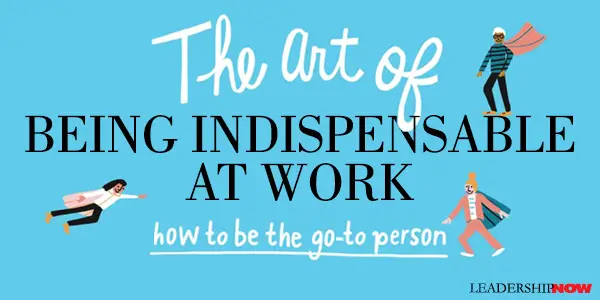
WHO doesn’t want to be that indispensable go-to person? To do that, though, it seems like you must say yes to everybody and everything. To overcommit. Bruce Tulgan, the author of The Art of Being Indispensable at Work, says overcommitment actually gets in the way of being that go-to person. The process of trying to become indispensable too often means stretching oneself beyond human capacity so that priorities become muddled. Important tasks are left undone or done ineffectively. All of this might leave you wondering when all of this collaboration business is going to blow over so that you can get back to doing your real job. In short, we all need to work together. When we help others succeed, we all succeed. It not good enough for one department to get it right. All departments need to get it right with coordinated responses that are aligned with the company strategy. The way of the go-to person is not to do everything for everybody. That only leads to the overcommitment syndrome. But they do as much as they can do well. The go-to person approaches “every relationship determined to add value to every interaction and to every other person.” In practice, you may have reservations about how this is even realistically possible. Issues like overwork, lack of accountability, lack of authority, how to say no and yes, arrogance are all addressed by Tulgan. Real influence is what makes the go-to person the go-to person. “Real influence is the power you have when other people really want to do things for you, make good use of your time, and contribute to your success.” The way to build it is by serving others “by doing the right thing for the long-term, moment by moment, adding maximum value in every single interaction.” It is important, too, to “know what is required and what’s allowed—up and down the chain of command—before you try to work things out at your own level.” The key here is alignment. Before you can work things out at your own level, you must be sure that you are aligned with the people making decisions. Good communication up and down the chain of command is how to make sure that happens. Whether to say yes or no is about how you will spend your time. Alignment with the ultimate decision-makers gives clarity to this process for you and allows you to provide clarity for those below you. “Knowing what decisions are not for you to make is like having guardrails. Within those guardrails of vertical alignment is where you have the discretion—the authority and the burden—to field those asks all day long and make tough decisions about yes and no.” Tulgan says you first need to fine-tune the ask. “The ask is the time o drill down before you overcommit or, more likely, before you wrongly commit.” You need to consider what exactly is being asked for, what it will take, and are you able to provide what is needed. Say no when you cannot do it (you don’t have the skill, knowledge, or time), when you are not allowed to do it, or when you should not do it. “Every good no makes room for a better yes.” A successful yes is based on a good plan of execution. That includes working smart and finishing what you start. “Work smart by professionalizing everything you do, specializing in what you do best, and steadily expanding your repertoire of specialties. Know what you want to be known for.” Specializing in what you do best is not just doing what you like best. You must be proficient at all aspects (like paperwork) of what you do or like to do best. Too many people make the mistake of thinking that the key to being a go-to person is being the hardest worker. And hard work is very important, of course. But if you work really hard at doing the wrong things or doing things wrong, you are not adding value. Don’t juggle. You need focus to finish what you start. You can only finish one thing at a time. If you want to be indispensable at work, you need to be known for executing on one important thing after another very well, very fast, all day long. That means powerfully contributing to the value of those things—be they meetings, emails, conversations, research, whatever—by giving them your full focused attention. The go-to person makes a concerted effort to get better and better at working with others. To improve relationships, make gratitude one of your trademarks and opt for continuous improvement. If you are smart, you realize quickly that you cannot be a true go-to person just by being great at the technical aspects of your job. Relationships are critical. But you cannot build the kind of relationships you need by working around the system, sidestepping rules, playing politics or making friends with the right people. You cannot make yourself powerful just by being a steamroller who won’t take no for an answer. Nobody will want you to be successful and powerful either if you turn everything you do into a favor that you add up on a ledger tally, and expect something in return quid-pro-quo style. Becoming a go-to person is not easy and requires practicing the principles presented here over time. These ideas also have benefits outside of work too. Serving others makes you the kind of person others want to help succeed. That kind of influence is indispensable. 
Posted by Michael McKinney at 08:00 AM
03.15.21

The Competitive Ecosystem: Thinking Ahead to Interconnectedness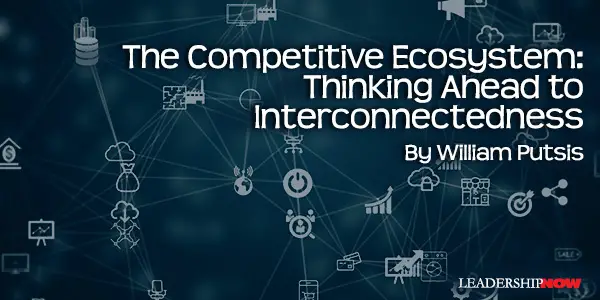
IN 1982, then graduate students at Carnegie Mellon, Michael Kazar and David Nichols, devised an early IoT (Internet of Things) experiment. Recalls Kazar, “There was a Coke machine on the third floor of this eight-story building, and people didn’t like the fact that they would go down all the way to the third floor and discover that the Coke machine was empty. Someone said, ‘Hey, why don’t we set it up so the Coke machine is on the Internet?’”  In many ways, this early prototype illustrates what IoT is all about — in principle, the Coke machine could automatically reorder supply when stock was running low or dynamically change prices, depending upon stock or demand. Coke suppliers would know ahead of time that supply needed to be increased because the demand at vending machines was increasing. Indeed, the interconnected vending machine had the potential to impact bottlers, distribution (for firms supplying vending machines), repair and maintenance companies that service the vending machines, and even the demand for coffee in the building’s cafeteria that might benefit from vending machine stock-outs. And the list goes on. One simple idea, connecting vending machines to the internet, had the potential to affect multiple industries. This type of interconnected ecosystem makes today’s economy so unique. One action affects multiple value chains across multiple, high- and low-tech industries alike. From internet-enabled vending machines in 1982 to traffic lights in 2018 In December 2018, Larry Page, the cofounder of Google and CEO of Google’s parent company, Alphabet, attended a gathering of about 200 of the country’s top CEOs in New York. In front of this group, he was asked what he would do with the $86 billion in cash that Alphabet had at the time (mostly overseas) when tax policy changed so that he was able to bring that money back to the United States with more favorable tax treatment. His answer was surprising yet telling: “traffic lights.” In fact, two other times in the next 10 minutes, he was asked about topics that had absolutely nothing to do with traffic lights and his answer each time was “traffic lights.” Page went on to explain that he sits at his desk in Mountain View, California, most mornings and watches his employees sitting at a traffic light, waiting to come to work. Oftentimes, no traffic is moving in any direction. He sees this as a waste of time that reduces productivity and impacts the environment from engines idling for minutes at a time. However, with his answer, he wasn’t actually talking about traffic lights. He was thinking many steps ahead and looking into a future when cars are automated and start talking to each other. Cars will slow, not stop, for other cars automatically. Accidents will be avoided and traffic will flow smoothly and unimpeded. We won’t need traffic lights at all. In order for this to happen, however, an ecosystem must be built. Cars need to be increasingly autonomous and inter-vehicle communications must be predictable and secure. The elimination of traffic lights would be the result of successful interconnected vehicles, not the objective of interconnecting them. It’s about building all of the components of the ecosystem so that we won’t need traffic lights. In order to fully understand the ramifications, think to the demands on our infrastructure. For example, there are constant and never-ending calls for more roads to alleviate congestion in urban and suburban areas. However, in a world where most traffic is autonomous and interconnected, we would actually have an over-abundance of roads. The impact of autonomous, interconnected vehicles extends well beyond automobile (and related) production to impact road construction-related firms and industries — from asphalt and paving companies to heavy equipment to laborers to local municipal and federal highway budgets. All of this requires thinking many steps ahead. Indeed, Larry Page and Sergey Brin, the two cofounders of Google, are the only two individuals publicly talking about strategic control points in interconnected markets. They clearly get it. All of this suggests three things to think about beyond products to platforms and beyond platforms to ecosystems: 1. Think ahead. The issue with traffic lights isn’t about traffic lights — it’s actually about no longer having a need for traffic lights. The interconnected Coke vending machine was about not needing to go down several floors in the building to find out about the stock levels. 2. Know the underlying needs. Saving time is an underlying need in both stories. 3. Think “right to left,” not “left to right,” and avoid incrementalism. Think where you want to be (the “right” end of a timeline) and work back to today (the “left” side of a timeline). Then, ask what you can do today (connect a vending machine, eliminate traffic lights) to get to the vision you have at the end of that timeline.  
Posted by Michael McKinney at 12:47 AM
03.12.21

Nine Key Strategies for Going Beyond Great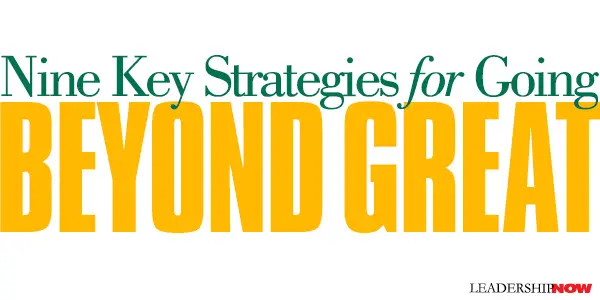
TO THRIVE in a new, more tumultuous era of social tension, economic nationalism, and technological revolution, you need to go beyond great. Great is no longer good enough. In Beyond Great, three partners from the Boston Consulting Group—Arindam Bhattacharya, Nickolaus Lang, and Jim Hemerling—make the point hat being great is no longer good enough to succeed when the very notion of outstanding business performance is being reinvented. There are three fundamental forces that are transforming the nature of global businesses. First is the interrelated tension created by the “worsening of the strain on our natural ecosystem and the rising discontent with capitalism and the resulting inequality.” Second is “rising economic nationalism and the ongoing erosion of U.S. hegemony.” And third is “a technological revolution fueled by the exponential growth of global data and digital technologies.” With this in mind, they offer a new standard of performance defined by nine key strategies in three areas—growth, operation, and organization. Growing Beyond: Redefine What Great Growth Looks Like Strategy #1: Do Good, Grow Beyond Reimagine core operations to deliver societal impact and hence long-term, sustained total shareholder returns rather than regarding social impact as an activity apart from the core. Firms that can thoughtfully integrate doing good into their strategies and operations will deliver sustained high shareholder returns while positively impacting all stakeholders. Strategy #2: Stream It, Don’t Ship It Offer compelling digital solutions and experiences, not just physical products or services. Today’s leading-edge companies are taking complete ownership of outcomes and experiences for customers. Leveraging digital technologies, they’re going deep into the usage life cycle to fulfill unmet needs, either grafting new solutions onto physical products and services or replacing physical products and services entirely. Strategy #3: Refine Your Global Game Grow selectively (that is, where they can claim profitable market share) and in ways suitable for the local environment, not everywhere all at once. Leading-edge firms are using asset-light, digital, or e-commerce-centric business models to enter into new markets and expand rapidly. They’re also becoming more selective about which markets to enter and paradoxically deepening their reengagement in their chosen markets. Operating Beyond: Rethink How Their Companies Operate Strategy #4: Engineer an Ecosystem In addition to conventional supply chains, many global companies are forming digital ecosystems as new-age value networks to create and deliver solutions, outcomes, and experiences that customers crave. But as leading-edge companies are discovering, some ecosystems work better than others. Strategy #5: Flex How You Make It Invest in high-tech, multilocal factories and delivery centers that, combined with low-cost capabilities, can deliver customized offerings fast. Today’s delivery models must be high speed, responsive, and resilient in the face of disruption, in addition to low cost. Strategy #6: Let the Data Run Through It Build a global data architecture and analytical capabilities to underpin the other eight strategies. Leading-edge companies regard global data as the precious fuel that not only predicts future performance or consumer behavior but also drives winning value propositions. Organizing Beyond: Constantly Reinvent How Their Company Is Organized Strategy #7: Get Focused, Fast, and Flat Move away from the traditional matrix organizational model in favor of agile customer-focused teams supported by platform capabilities. Bureaucracy and distance from the customer are death in an age of volatility—and today’s leading-edge firms know it. Strategy #8: Thrive with Talent Acquire, retrain, inspire, and empower a digitally savvy, engaged workforce. Companies today must attend more closely to what a new generation of employees wants and needs. They must fundamentally shift how they find, inspire, and develop a twenty-first-century workforce. Strategy #9: Embrace Always-On Transformation Embrace always-on transformation instead of traditional one-and-done change initiatives. This strategy is essential for succeeding with the other eight. To compete and win in volatile, rapidly evolving business environments, global companies must become adept at pursuing multiple transformations on an ongoing basis.
Each chapter concludes with advice for leaders and a helpful section on key insights. What all of this demands of a leader, aligns with what you’ll find elsewhere on this website: lead with conviction, be open-minded, elevate and embed a continuous learning mindset, embrace transformational leadership, and develop the ability to navigate through ambiguity, tension, and paradox. 
Posted by Michael McKinney at 09:18 AM
03.11.21

Leading Thoughts for March 11, 2021
IDEAS shared have the power to expand perspectives, change thinking, and move lives. Here are two ideas for the curious mind to engage with: Mike Hayes on delegating and an insight as to why we lead: “We don’t need to assert the greatest amount of authority that we’re entitled to. Our organizations are better served by training the people below us to one day take our place. The more we can pass down the chain of command, the better equipped our organizations will be, with more capable leaders throughout.” Source: Never Enough: A Navy SEAL Commander on Living a Life of Excellence, Agility, and Meaning Mark Thomson on leading transformation: “You are not going to succeed as a CEO if you try to impose a set of ideas or a new culture Day 1. It just doesn’t work. It’s got to be owned. It’s more a question of trying to pull it out of the organization rather than push it in, and that meant trying step-by-step to encourage a deeper conversation about the future.” Source: As quoted in The CEO Test Look for these ideas every Thursday on the Leading Blog. Find more ideas on the LeadingThoughts index.
Posted by Michael McKinney at 12:26 AM
03.09.21

The Seven Tests of A CEO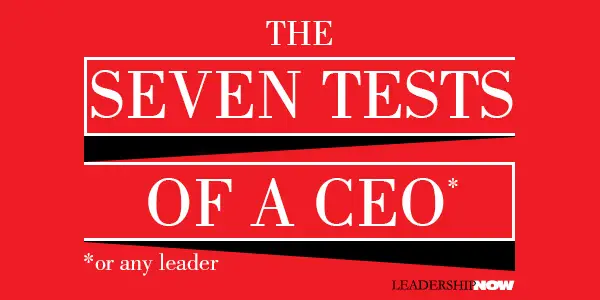
WHAT are the critical challenges that can make or break a leader? In The CEO Test by the always insightful Adam Bryant and by the former Amgen president and CEO Kevin Sharer, they present seven tests that really all leaders face in one form or another. They call it the CEO test because the intensity and consequences of these challenges grow as you move into higher levels of leadership. As a result, these challenges are brought into their sharpest relief and thereby provide the richest lesson for anyone aspiring to lead better. They believe that “to succeed in a leadership role, you have to achieve a certain threshold level of proficiency in each of the skills” highlighted in these seven tests. So, they are worth reflecting on no matter what context you lead in. The best leadership advice, after all, helps slow the game, so that you can better anticipate, understand, and label the nuanced dynamics of different situations in the moment and then guide them to better outcomes. Test #1 Can You Develop a Simple Plan for Your Strategy? This test begins with the ability to crystalize the issue or idea in simple terms and then create a clear, galvanizing plan to get everyone moving in the same direction. The simple plan should “address two questions that every employee deserves to have an answer to: What should I be working on? Why is it important?” Bob Iger of Disney writes: If you don’t articulate your priorities clearly, then the people around you don’t know what their own should be. Time and energy and capital get wasted. You can do a lot for the morale of the people around you (and therefore the people around them) just by taking the guesswork out of their day-to-day life. Two great questions to ask: “What three or four things that, if we accomplish them over the next twelve months, will make this a good year?” and “What are the areas that are going to get new or greater focus to achieve the outcome?” Test #2 Can You Make the Culture Real — and Matter? How are we going to work together? Building a strong culture is a critical test for leaders. “Done right, culture will engage something deeper within employees’ sense of themselves, ideally in ways that are aligned with business goals.” Robert Johnson, co-founder of Black Entertainment Television said: Culture is almost like a religion. People buy into it and they believe in it. And you can tolerate a little bit of heresy, but not a lot. If there are not clear and consistent guidelines for behavior, or if they are not reinforced and modeled every day by the top leaders, cultures can devolve into hives of dysfunction, insecurity, fear, and chaos. Test #3 Can You Build Teams That Are True Teams? This test brings us to four questions: What is the purpose of the team? Who should be on the team? How will the team work together? What is the leader’s role on the team? Teams need to evolve or grow with the times they are in. They need to have a “forward radar,” says the former CEO of Aetna, Ron Williams. “What you see is that some people aren’t evolving with the complexity of the business, and their ‘forward radar’ is diminished and keeps getting diminished.” Or as former CFO of the Disney Interactive Media Group, Bruce Gordon, puts it, “Very few people are bad at their job, but many are not as good as they must be.” We debate like we’re right, listen like we’re wrong, and then decide, commit, and lead together. Test #4 Can You Lead Transformation? The status quo is not an option. Even in institutions where the message never changes, the environment it is in does, and therefore delivery changes. The challenge is to disrupt yourself before you become obsolete. A couple of guidelines: Clarify what is not going to change, particularly mission and purpose, to make employees more open to new approaches for accomplishing their work. On the subject of what’s not going to change, The New York Times publisher, Arthur Sulzberger, says that it is important to separate mission from tradition. “Mission should never be tinkered with. You mess with mission at your own risk. Tradition needs to be constantly interrogated.” But he adds that you need to be very clear about your reason for being. “If everything is up for grabs, if you can change literally anything about a company, then the company has no reason for being.” Test #5 Can You Really Listen? How do you know what you need to know? The danger is walling yourself off from any kind of skepticism. Kevin Sharer, former CEO of Agmen, “It’s not just about listening to the person across the table from you. Listening is actually being alert to the whole ecosystem in which you operate.” You have to be able to separate the signal from the noise. “That’s not an easy thing to do because most of the communications that come to you are curated to have a pleasing tone.” Clue: “Watch how funny your jokes get.” Test #6 Can You Handle a Crisis? A crisis often emerges out of uncertain times. It can come from without and from within. If you have passed the first five tests, you are much more likely to better handle the next crisis. The particular challenge of leading in a crisis is to bring some predictability to moments of intense unpredictability and stress, when so much is on the line, including your own and your organization’s reputation. It is essential that the leader is visible because they set the tone that others will follow. It’s a good time to reimagine your organization. A crisis creates a rare opportunity to revisit long-standing assumptions about your organization. Ideas that may have seemed impossible to tackle are suddenly on the table. How well you survive a crisis is really determined by what you have done before the crisis. “Any weakness in your organization will be exposed and magnified. Your ability to handle a crisis will be a direct result of how well you led before the crisis.” That leads us to the next and final test. Test #7 Can You Master the Inner Game of Leadership? The other six tests were about things a leader must do. This test is about what a leader must be. As such, this test underpins the others. How well you master the inner game of leadership will help you in mastering the other six areas. Leadership is not easy, but Bryant and Sharer believe that if you understand it as a series of paradoxes, you will be better able to become the leader you need to be. They present seven: Be confident and humble
To make it about others, you need to acknowledge the pressures, keep your ego in check, focus on a few achievable goals, make yourself dispensable, and don’t forget to make the time to recharge yourself. 
Posted by Michael McKinney at 10:11 PM
03.05.21

Never Enough … Excellence, Agility, and Meaning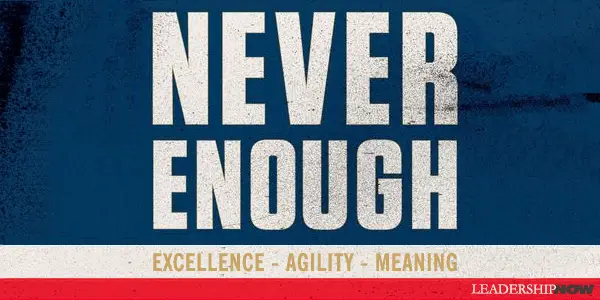
THE IDEA behind Never Enough isn’t perfection or even a state of dissatisfaction. It’s about realizing that the goal is not to get by but to “always look for more ways to make an impact.” Former Commanding Officer of Seal Team Two and White House Fellow serving with both George W. Bush and Barack Obama, Mike Hayes, says Never Enough is about aiming for excellence, agility, and meaning in everything we do. Adopting this mindset can “drive us all to lead more complete, more rewarding lives, each making the world a better place in our own unique way.” Never enough means realizing our full potential—intentionally. On an individual level, we must never look to be Never Excellent Enough and build our own capabilities in terms of knowledge and capacity, strength and control, and accountability and orientation. Never Excellent Enough Never excellent enough begins with knowing yourself and then having the will and the drive to do the work and stretch yourself. “The hungriest people will, in fact, do whatever it takes, and they’ll get better and better along the way.” It’s never easy. The discomfort lets you know you are on the right path. The way to get better over time is to know where we aren’t good enough, what aspects of our life are not satisfying enough, which goals we’re chasing aren’t the right ones. Our reactions are critical. Hayes says he’ll take control over raw intelligence. “The smartest SEAL isn’t the one with the greatest raw intelligence. It’s the one who has the best and quickest reaction to a problem. You want both—intelligence and control—but in the stressful moments, control matters, a lot.” In stressful circumstances, as leaders, we need “to be the person to pull others up, set the right tone, and keep everyone else on track.” Here’s the bottom line: We can’t—and shouldn’t—erase emotions from our lives. We can’t be good partners, friends, spouses, and parents without emotion, without feelings, without vulnerability and genuine honesty. But we also can’t be effective performers if we aren’t able to compartmentalize, to put those feelings aside when they’re not helpful to the situation at hand. Of course, the key to never enough excellence is humility. It means putting others first in all things. I needed to be humble enough to let others take the lead when their skills were the ones we most needed in the moment, and confident enough that I didn’t need to prove my worth and ultimately hurt the mission by trying to do what might be better handled by someone else. Hayes adds, “you’re not going to be the most productive performer unless you have the right attitude about the people around you.” And this goes when there is a need to discipline too. Discipline is not about you, “it’s about making people understand where they fell short, helping them to change their actions in the future, and altering their perspective.” And remember this: If someone is going to stay on the team, you make them better. If they need to leave, you let them leave with dignity and, in doing so, make them an ally in the future. Never Agile Enough Agility is about awareness and being flexible enough to do what needs to be done to get the desired outcome. That requires that you can be both a leader and a follower. Hayes calls it “dynamic subordination.” He says, “In an effective team, we must seamlessly move forward and back depending on the demands of the situation and the skills of the people around us. We don’t get locked into a particular job, a particular task, or a particular pattern: we maintain the agility to be whatever we need to be under the circumstances.” Dynamic subordination also has a flip side. When you are in a position to make the lives of the people around you better, step up. Always be ready to do what you can do. What plays into agility is knowing how to think. Have a process for decision-making that includes getting the broadest range of thought that you can. The concrete knowledge you need is the easy part—anyone can learn that. But the details don’t matter if you don’t have the right process. And if you do have the right process, you can go anywhere. It’s why strong leaders are able to jump from one industry to another, one organization to another. Some rules are made to be followed, and some are to be broken. Agility is knowing when to do which. Hayes asks everyone to think on two levels: run, and renovate. “You need to get the job done in the moment (‘run’) but you also need to figure out what might need to change to enable the greatest amount of long-term success (‘renovate’).” But run and renovate is about more than just making changes it should become part of everything you do. “When you push a teammate—when you challenge something they’ve done or try to initiate a hard conversation—you need to be thinking about how you’re trying to affect them in the moment (‘run’) and how you’re trying to shape their future (‘renovate’).” Never Meaningful Enough We all want to have meaning in what we do and impact the lives of those around us. It begins by having a belief system in place. Believe in something and start there. “The hard work is figuring out what the world needs and how it intersects with what feels most rewarding to you. Figure that out, and actually getting it done becomes the easy part.” Having an impact on others means getting to know others and having deep conversations. Hayes lives by three principles in this regard: “to be intrusive in people’s lives, to be a do-er rather than a be-er, and to push to have real impact on those around me.” That doesn’t mean being rude or overstepping other people’s boundaries, but “we have to be willing to intrude, to ask the hard questions and have the hard conversations—or we’re not really making a difference.” Being a do-er for others “means actually doing concrete things that make a difference in our friends’ lives, often at a cost to ourselves.” And impacting the lives of others gives meaning to our own lives as well. Never enough means it’s never over. I think we can simultaneously recognize how much we accomplish each day and also understand that our work is never done. There is always growth possible for each of us, ways we can push ourselves to be more excellent, more agile, and infuse our day-to-day with more meaning. There are always more people whose lives we can touch, more people we can lift up and inspire to get better and reach greater heights. Never Enough is an outstanding book. There is so much in the way of reliable, balanced advice. His wide-ranging experience—as a Navy SEAL, a White House Fellow, Chief of Staff and COO at Bridgewater Associates, and Head of Strategic Operations at Cognizant Technologies, among other roles—made his insights even richer. 
Posted by Michael McKinney at 12:14 AM
03.04.21

Leading Thoughts for March 4, 2021
IDEAS shared have the power to expand perspectives, change thinking, and move lives. Here are two ideas for the curious mind to engage with: Performance psychologist Jim Loehr on motivated reasoning: “The facts are facts, but we ignore, alter, or otherwise twist them to allow us to continue doing what we are doing. Once we learn we can get what we want by altering the logic chain, by embracing ‘facts’ that align with the outcome we want and dismissing those facts that don’t, no behavior is safe. No value, no belief is safe.” Source: Leading with Character: 10 Minutes A Day to A Brilliant Legacy David C. Valliere on the need for entrepreneurs to think and to think differently: “Thinking is hard work. If you tell people they are thinking, they will love you. But if you actually make them think, they will hate you. Thinking carefully and precisely is very hard work – perhaps even harder than the physical labor of digging ditches, or the emotional labor of smiling at retail customers. Chess grandmasters can burn thousands of calories as they sit there, motionless, or occasionally lifting one hand to move a small piece weighting only a few grams. Because with their minds, they are expending huge amounts of energy. Most people will go to great lengths to avoid working so hard. They look for shortcuts and simplifications. They rely on ‘common wisdom’ and shared ‘rules of thumb’ without doing the hard work of checking things out for themselves. And these are the shortcuts that sink new entrepreneurs.” Source: Entrepreneurial Thinking: Think Different! Look for these ideas every Thursday on the Leading Blog. Find more ideas on the LeadingThoughts index.
Posted by Michael McKinney at 03:08 PM
03.01.21

First Look: Leadership Books for March 2021Here's a look at some of the best leadership books to be released in March 2021. Don't miss out on other great new and future releases not listed here.
Are you ready to lead? Will you pass the test? The CEO Test is the authoritative, no-nonsense insider's guide to navigating leadership's toughest challenges, brought to you by authors uniquely qualified to tell the stories. Adam Bryant has conducted in-depth interviews with more than 600 CEOs. Kevin Sharer spent more than two decades as president and then CEO of Amgen, where he led its expansion from $1 billion in annual revenues to nearly $16 billion. He has served on many boards and is a sought-after mentor for CEOs of global companies. Leadership is getting harder as the speed of disruption across all industries accelerates. The CEO Test will better prepare you to succeed, whether you're a CEO or just setting out to become one.
Modern knowledge workers communicate constantly. Their days are defined by a relentless barrage of incoming messages and back-and-forth digital conversations--a state of constant, anxious chatter in which nobody can disconnect, and so nobody has the cognitive bandwidth to perform substantive work. There was a time when tools like email felt cutting edge, but a thorough review of current evidence reveals that the "hyperactive hive mind" workflow they helped create has become a productivity disaster, reducing profitability and perhaps even slowing overall economic growth. Equally worrisome, it makes us miserable. Humans are simply not wired for constant digital communication. The question is not whether a world without email is coming (it is), but whether you'll be ahead of this trend. A World Without Email will convince you that the time has come for bold changes, and will walk you through exactly how to make them happen.
Burnout has become one of the most talked about workplace topics, and its impact is far-reaching. The 24/7 pace of work, constant demands, and scant resources can easily put busy professionals on a path to burnout, a cycle that has only accelerated during the COVID-19 pandemic. Burnout affects the health and well-being of the entire organization, yet most attempts to help focus on quick-fix strategies aimed at individuals. Something is missing. Davis’s research-driven, fast-reading, and actionable book is the first of its kind to explore a new solution to the burnout problem at work: a comprehensive approach focused on building the resilience of teams of all sizes.
Why do startups fail? That question caught Harvard Business School professor Tom Eisenmann by surprise when he realized he couldn’t answer it. So he launched a multiyear research project to find out. In Why Startups Fail, Eisenmann reveals his findings: six distinct patterns that account for the vast majority of startup failures. Drawing on fascinating stories of ventures that failed to fulfill their early promise—from a home-furnishings retailer to a concierge dog-walking service, from a dating app to the inventor of a sophisticated social robot, from a fashion brand to a startup deploying a vast network of charging stations for electric vehicles—Eisenmann offers frameworks for detecting when a venture is vulnerable to these patterns, along with a wealth of strategies and tactics for avoiding them.
The Eight Pillars of Trust (Clarity, Compassion, Character, Competency, Commitment, Connection, Contribution, and Consistency) are based on Horsager's original research and extensive experience working with Fortune 500 companies and top government agencies around the globe. In addition to the business parable, this book is rich in practical advice for implementing each of the Eight Pillars. You will learn strategies to increase alignment, overcome attrition, and get absolutely clear on executing your top priorities. Horsager offers a road map for how to become the most trusted expert in your industry.
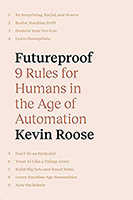 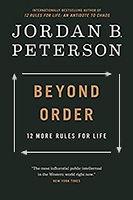 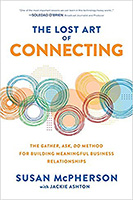
 Build your leadership library with these specials on over 28 titles. All titles are at least 40% off the list price and are available only in limited quantities. “The great thing is to be always reading but never get bored—treat it not like work, more as a vice.” — C. S. Lewis
Posted by Michael McKinney at 07:46 AM
|
BUILD YOUR KNOWLEDGE


How to Do Your Start-Up Right STRAIGHT TALK FOR START-UPS 
Grow Your Leadership Skills NEW AND UPCOMING LEADERSHIP BOOKS 
Leadership Minute BITE-SIZE CONCEPTS YOU CAN CHEW ON 
Classic Leadership Books BOOKS TO READ BEFORE YOU LEAD |
|